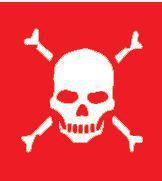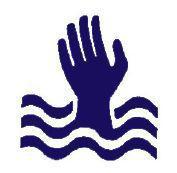SAS Urban Survival Handbook (134 page)
Read SAS Urban Survival Handbook Online
Authors: John Wiseman
Tags: #Health & Fitness, #Reference, #Survival, #Fiction, #Safety, #Self-Help, #Personal & Practical Guides, #General, #Survival Skills
RECOVERY POSITION
When a casualty’s heart is beating and the casualty is breathing, place them in the recovery position to keep the airway open. This is particularly important if the casualty is unconscious. If left on their back, a casualty is at risk of suffocation or choking by the tongue falling back into the throat and blocking it, or by choking on their own saliva and vomit. Spectacles/loose dentures should be removed.
Face down, with the head in the correct position, the tongue will fall forward and fluids will drain from the mouth. You may not see any reason WHY a casualty should vomit but it is common, especially on regaining consciousness.

WARNING
NEVER attempt to roll a casualty into the recovery position if a head, neck or spinal injury is suspected. It is better to support the casualty’s head in the position in which it was found. If breathing becomes difficult and there are at least six other responsible first aiders, it is possible WITH GREAT CARE to attempt to turn the casualty over (see below). Try opening the airway first.
ALWAYS monitor a casualty’s breathing—if it becomes laboured or noisy, the airway may not be properly open. Check the position of the casualty’s head.
ALWAYS use the recovery position, unless you are examining the patient or applying first aid to other injuries. While doing so, if there is breathing difficulty the recovery position is essential.
Draw the ‘upper’ arm and leg away from the body, to stop the casualty lying flat. Turn the head in the same direction, angling it back on the neck (with jaw jutting out) to keep airway open. Monitor ☚ BREATHING and ☚ PULSE.

SPINAL/NECK INJURIES
If there is a suspected spinal or neck injury and the casualty’s breathing becomes noisy or laboured, it is VITAL to try to open the airway. ONLY try to do so if absolutely necessary! The ideal position for a conscious casualty is lying flat on their back with head supported at each side. Try to lift the lower jaw with the head stationary. If this does not work, angle the head back and lift the jaw VERY GENTLY.
If breathing is very difficult, and there are at least six other responsible first aiders, attempt to turn the casualty. One person (you) should hold the head, while three people position themselves on either side of the casualty.
VERY VERY CAREFULLY roll the casualty onto their side. The spine and neck must be constantly supported in the neutral position and NOT allowed to twist or arch in any direction. Continue supporting the head until help arrives.

WARNING
Spinal/neck injuries: If you suspect that a casualty has suffered a severe back/neck injury, extreme care should be taken in moving them. The casualty should ONLY be moved if they are in more extreme/immediate danger—in a burning building for example. If possible, do NOT move the casualty. Signs of severe back/neck injuries include a loss of feeling/movement below the injured area. A tingling/pins-and-needles sensation in hands/feet often denotes a neck injury. There may be an inability to feel stimuli to skin, and breathing may be weak or laboured.
HEAD INJURIES
A heavy blow to the head, possibly causing bruising or bleeding, may also cause a skull fracture. A skull or brain injury is possible without external signs. After a fall or other blow to the head, a casualty’s condition MUST be monitored for several days IN ALL CASES. Seek medical attention.
Concussion
Concussion is likely after a severe blow. Unconsciousness may or may not occur. Often a very brief period of unconsciousness may be taken for granted—in other words, it’s over with so quickly that you tend to assume all is OK. But, the brain has been shaken and could be damaged.
Symptoms
- ◑ Shallow breathing
- ◑ Loss of facial colour
- ◑ Cold, possibly sweaty, skin
- ◑ Rapid weak pulse
- ◑ Possible nausea and/or vomiting
- ◑ Possible confusion/loss of memory regarding the ‘accident’
- ◑ Possible unconsciousness
If unconscious, there is a strong possibility of vomiting. Place casualty in the ☜ RECOVERY POSITION (if no spinal/neck injuries are suspected). Monitor breathing and pulse. If consciousness does not return, check level of response by pinching some skin on the casualty’s arm or hand. Look at your watch and note WHEN the casualty fails to respond to pinching or commands to open their eyes. It could be important later on. There is a great likelihood of brain compression.
SEEK URGENT MEDICAL ATTENTION.
BLAST/EXPLOSION INJURIES
If the casualty has been caught in the blast of an exploding bomb—or even a domestic or workplace explosion involving gas or chemicals—there may be several types of injury.
While waiting for help to arrive, look for signs of fractures, head injuries, burns and lacerations from flying glass and debris. The lungs and other internal organs may also be affected.
Reassure and calm the casualty. DON’T move more than necessary. Treat all injuries according to their seriousness.

WARNING
Compression of the brain may develop hours or days after the initial injury. SEEK URGENT MEDICAL ATTENTION.
Compression
If blood/fluid is building up inside the skull, causing pressure on the brain, symptoms may include:
- ◑ Strong slow pulse
- ◑ Numbness, tingling or paralysis of part of the body
- ◑ Flushed face
- ◑ Noisy laboured breathing
- ◑ Uneven pupil size
- ◑ Possible rise in body temperature
This is an emergency.
CALL AN AMBULANCE.
TELL THEM YOU SUSPECT COMPRESSION FROM A HEAD INJURY. If the casualty loses consciousness while you are waiting for the ambulance, place in recovery position and monitor breathing and pulse.
Skull fracture
After a severe blow to the head—in a fall or motoring accident for instance—a skull fracture may result. Symptoms include:
- ◑ Similar symptoms to
concussion
and
compression. - ◑ There may be blood or straw-coloured fluid leaking from the nose, ears or eyes.
- ◑ There may be obvious surface signs on the head itself—a soft area, a depression or obvious fracture.
If no spinal/neck injury is suspected, place casualty in the ☜ RECOVERY POSITION. If fluid is leaking from one ear only, turn the head to allow the fluid to leak directly downwards. Be very gentle. Monitor breathing and pulse and look out for symptoms of ☜ COMPRESSION.
This is an emergency.
Call an ambulance.
TELL THEM YOU SUSPECT A SKULL FRACTURE.
CHEST INJURIES
A chest wound can give rise to a life-threatening situation, which will require immediate action. Lung function may be impaired, affecting ☜ BREATHING. A wound may cause ☜ SEVERE BLEEDING. Danger signals of a severe chest injury include bright-red frothy blood coughed up by the victim, the sound of air being sucked into the chest and bloodstained liquid bubbling from the chest.
Seal open wound with hand or a credit card. You may need to use quite a lot of pressure and maintain it until help arrives. Place victim in a half-sitting position, support head and shoulders. Turn victim so that unaffected lung is uppermost.
Cover wound with sterile dressing—try to make dressing airtight by covering with plastic sheet or metal foil. Be alert for symptoms of ☜ SHOCK. If victim loses consciousness place in ☜ RECOVERY POSITION.
DROWNING
 Not all drowning victims have water-filled lungs. In most cases, quite small quantities of water may enter the lungs. Occasionally the airway goes into spasm as water tries to enter, thereby causing asphyxiation. When water does enter the lungs, it impairs their ability to transport oxygen into the blood.
Not all drowning victims have water-filled lungs. In most cases, quite small quantities of water may enter the lungs. Occasionally the airway goes into spasm as water tries to enter, thereby causing asphyxiation. When water does enter the lungs, it impairs their ability to transport oxygen into the blood.
